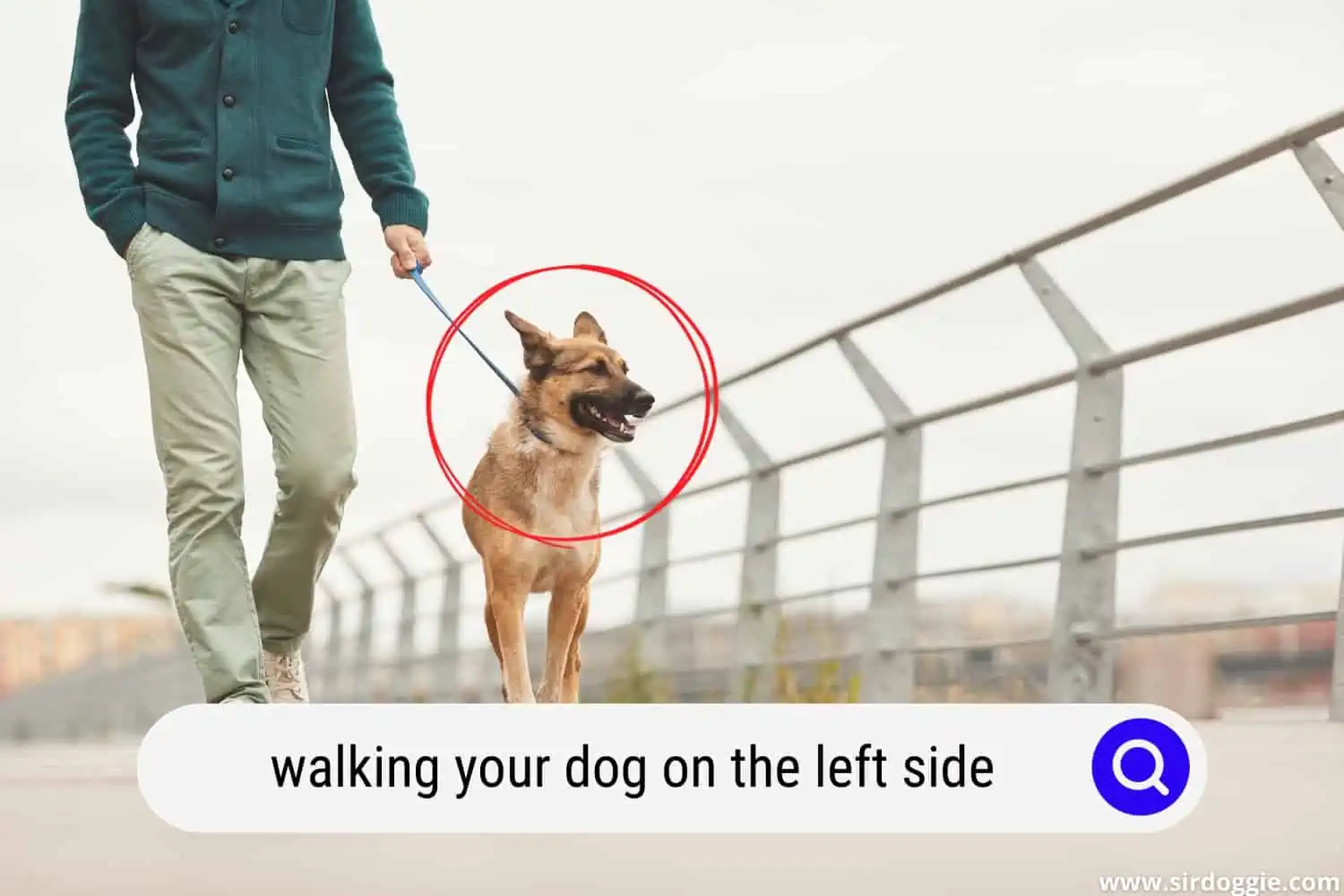Why Should You Walk Your Dog on the Left Side?
Dogs become very excited by all the new sights and smells they experience on a walk. Because of these exciting additions to their surroundings, it’s very common for dogs to pull on the leash, and it’s our job as their owners to teach them not to. It’s common for dogs to be trained to walk on the left side for a variety of reasons.

So, why do we walk dogs on the left side? We walk dogs on the left side because that’s what we train them to do. Left side walking teaches your dog that you are a more dominant pack member than they are. However, it’s your dog walking on a loose leash and viewing you as their leader that shows your dominance; there’s nothing special about the left side. They are just as likely to be submissive and walk properly on the right side. The primary reason most dogs walk on the left is that most people are right-handed. If you hold your dog’s leash in your left hand, it leaves your right hand free to do other things.
Traditional left side walking
Most dog training books will tell you to teach your dog to walk on a loose leash on the left side with your dog in a “heel” position. But why the left side? The purpose of your dog’s walk is important, as well as how you teach your dog to walk on a leash, but the side doesn’t actually matter.
The best explanation for why the heel position is considered to be on the left side is simply that it’s tradition. It’s the way it’s been done by most dog owners and trainers for a long time, so it’s how we continue to do it.
The origin of the left-sided heel position lies in hunting dogs. When people took their dogs hunting, they kept the dog leashed on their left side so they could hold their guns on the right. Since most of us no longer hunt for our food or walk our dog while carrying a weapon, it’s probably safe to choose whichever side your dog, or you, prefer him to walk on.
Police dogs
In the same tradition as hunting dogs, police officers in K9 units train their dogs to lead on the opposite side they carry their firearm. If the K9 officer is right-handed, the dog is trained to walk on the left side. In contrast, a left-handed officer will usually train their dog to walk on the right. The catch is that the dog always walks on the same side he is trained on and doesn’t switch back and forth between sides.
Guide dogs
Another example of dogs who are always trained to walk on the left side is guide dogs. Unless the dog’s handler has an injury to their left side that prevents them from holding the leash there, seeing-eye dogs always walk on the left. This is critical for blind dog handlers who need to have consistency in their dog’s location. This way, the dog and the handler always know where the other one is.
Dogs in competition
For dogs that compete in shows, it’s important that the handler and the dog work in tandem and communicate clearly with each other. Certain events like obedience and rally require the use of the traditional left-side heel position. Other sports such as agility or freestyle require the dog to be able to work from both sides.
In sports where the dog needs to work from alternate sides, the command “heel” is used to designate attentiveness on the left side, and “close” asks the dog to go to whichever side the handler indicates with her hand. Regardless of the side, the dog is expected to be responsive to all commands given by the handler.
Why do we call walking on the left side heeling?
While no one really knows why we call your dog’s position on your left side heeling, there are some guesses for how the command came to be.
The term “heeling” comes from a behavior commonly exhibited by Blue Heelers (now called Australian Cattle Dogs). These dogs have been used since the 1800s to drive large herds of cattle across open fields or to round up groups of cattle to bring them in. When a cow strays from the herd and needs to be brought back, the dog nips at the back of the cow’s heel and then ducks to avoid a kick. This behavior is referred to as “heeling.”
Originally, a dog told to “heel” would take up a location slightly behind and to the left of their handler. When seen in practice, the term “heeling” is logical, as the dog is almost literally walking on your heels.
The heel position we practice today is more forward. The dog’s shoulder is usually allowed to come ahead of the handler’s leg, and the dog is allowed to make eye contact and pay attention to its handler. This is mostly a result of modern positive reinforcement training, something that wasn’t popular a few decades ago.
Can you walk your dog on either side?
While it’s obvious that walking your dog on the left side is rooted in tradition, is there any reason your dog needs to heel on the left side? The reasons for walking on the left side only apply to modern life if your dog is in competition. Even then, they should be trained to walk on both sides.
For practical reasons, you should train your dog to walk on either side of you. Depending on what you’re doing, there will be times when you prefer him on the right and times you prefer him on the left. However, most of us will end up with a side we prefer and that we walk our dog on most often. Which side is better might depend on where you live.
If you are walking your dog on city sidewalks and live in North America, where cars drive on the right side of the road, it makes more sense from a safety standpoint to walk your dog on the right. If you’re walking next to a road, this will put your dog on the opposite side of you from the traffic in most cases. If your dog were to accidentally dart to the road, they are less likely to get hurt. This, of course, changes if you live in a country where cars drive on the left side, so left side walking might be preferred in this case.

Related Questions
What side of the road do you walk a dog on?
You should always walk your dog on the same side of the road you would walk on yourself. This would be whichever side has you walking towards traffic. Ideally, you want to walk your dog somewhere with paths or sidewalks, but this isn’t always possible.
Is it okay if my dog walks in front of me?
There’s not a right way to walk your dog. Most dogs are taught to heel and walk beside their owners because they pull on the leash. Some dogs prefer to be out in front, and some owners don’t mind their dogs in front of them. The key is that there is slack in the leash, and your dog is not pulling. Otherwise, you have some training to do to teach your dog to walk properly.

Family Dog Expert Author
Hi there! I’m Stuart, a devoted dog lover and family dog expert with over a decade of experience working with our furry companions. My passion for dogs drives me to share my knowledge and expertise, helping families build strong, loving bonds with their four-legged friends. When I’m not writing for SirDoggie, you’ll find me hiking, playing with my beautiful dog, or studying music.